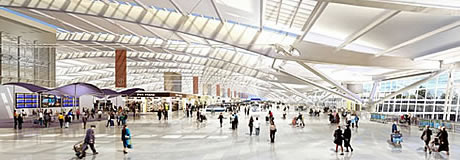All about Heathrow Terminal 5

Heathrow Airport's brand new Terminal 5 is set to open for business later this month, providing British Airways with its own single-location base. Much has been made of the shiny new building in the press, but what can travellers expect to gain from the impressive facility?
The Facts
Heathrow's fifth terminal is a spectacular feat of engineering. While it is not quite as astounding in design as the new terminal at Beijing Airport, Terminal 5 promises to offer a new breed of service for UK flyers.
Let's take a look at the numbers behind the terminal. Construction work on the complex began in September 2002, meaning it has taken about seven and a half years to build. The total cost of the terminal was £4.3 billion and is expected to see some 30 million travellers pass through its gates every year - pretty impressive considering just one airline is operating from the building.
Inside the terminal, British Airways passengers can expect to take advantage of almost 100 self-service check-in kiosks when they do not want to tackle any queues that might build up at the 54 manned check-in desks. This theme of ultra-efficiency via self-service is prevalent throughout the facility, as travellers can also make use of more than 90 check-in fast bag drops.
Other features include two security zones, 20 security lanes and 11 baggage reclaim belts, with 12,000 bags expected to be processed every hour. When it comes to killing time before boarding the plane, travellers will be able to idle away the hours in a total of 112 shops, restaurants and bars, or perhaps book into the luxurious Sofitel London Heathrow Hotel, opening in Summer 2008, if they have a longer wait.
Of course, all of this will not come on-stream immediately; the opening of the terminal is very much a staggered process. Phase one, to be completed in 2008, will see 50 aircraft stands across Terminals 5A and B, opened while a further 60 stands will be launched in Terminal 5C in 2010.
Hi-tech Heathrow
The building of Terminal 5 has presented an opportunity for Heathrow to integrate more technology into its operations - one that has been well and truly been taken. As well as the profusion of check-in kiosks, the hub is in the process of constructing a personal rapid transit system with a distinctly science fiction flavour.
This system involves the use of a fleet of battery-powered, low-energy 'pods' that do not require a driver as they journey along a dedicated guide way. These pods can carry up to four passengers as well as their luggage and are likely to provide a welcome alternative to traipsing the length of the terminal with a trolley laden with suitcases. It is expected to begin running in 2009.
Meanwhile, even Terminal 5's car parks make use of the latest technology. The multi-storey short stay car park utilises a bay monitoring system where each space is fitted with a sensor and light system to lead drivers to the most convenient free bay. A variable messaging system electronically offers directions around the car park, while automatic number plate recognition will be installed for those who have pre-booked spaces.
The car park also caters for those who have difficulty finding their vehicle on their return; the innovative Car Finder system enables motorists to use their ticket or enter their registration number at a kiosk, which will then inform them of the location of their car.
How will you benefit?
So what are the overall advantages of the new terminal? British Airways chief executive Willie Walsh says: "With the opening of Terminal 5, British Airways and BAA have an opportunity to make air travel, both into and out of the UK, once again a calmer and much more enjoyable experience."
Other experts appear to agree with the sentiment that while the terminal is built just for one airline, it will in fact help to improve service elsewhere in the airport. "Terminal 5 will provide visitors to London and the UK with a spectacular first impression and alleviate the pressure experienced at Heathrow, the world's busiest airport," comments Visit London chief executive James Bidwell.
Concerns have been raised over the terminal's environmental impact, with some campaigners claiming that the new facility will inevitably lead to the introduction of more flights and therefore higher carbon emissions. However, Ian Godden, chief executive of the Society Of British Aerospace Companies, said that passengers should remember that the aviation industry already has a strategy in place to cut noise and carbon emissions, the BBC reports.
"Under the industry's Sustainable Aviation strategy, aviation aims to cut noise and CO2 emissions by a further 50 per cent of 2000 levels by 2020," he remarks, adding: "The arguments made against Heathrow expansion fail to recognise the economic benefits of the airport and the voluntary steps being taken by the industry."
The future
Terminal 5 does not represent the end for Heathrow's transformation. Plans are afoot for a new facility to replace Terminals 1 and 2 - without adding extra capacity for more flights - called Heathrow East. The complex will feature a range of eco-friendly measures and it is hoped the terminal will be open in time for the 2012 Olympics. And - controversial as it is - a third runway at the hub could offer even more choice for passengers flying from London.
Change is also ongoing across other airports - Stansted in particular may get a second runway to cope with increasing demand for flights, while a number of regional airports are looking at increasing capacity or generally revamping their offerings to make travel a little bit easier for flyers.